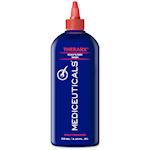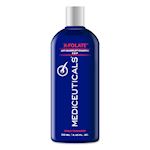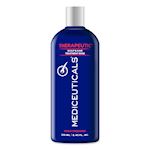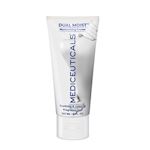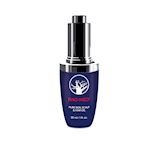-
SEBORRHEIC DERMATITIS: WHAT IS IT AND WHAT CAN YOU DO ABOUT IT?
Do you suffer from red spots and flaky skin with visible white or yellow flakes? On your scalp, face and chest? Then you may be suffering from seborrheic eczema. This is a chronic skin condition that is quite common. At least 5% of the population is affected. Men suffer from it slightly more often than women. In babies, the skin condition is known as cradle cap.
Seborrheic dermatitis is not contagious and quite harmless, but it is very annoying. You will experience itching and spots on your face and chest will not look nice. That's why you want to get rid of it as quickly as possible. But before that, it is first good to know what seborrheic dermatitis is and what causes it. In this blog, we provide answers to all those questions.
-
WHAT IS SEBORRHEIC DERMATITIS?
Seborrheic eczema is a chronic but often mild form of eczema and manifests itself in itching, redness and flakes. The face, scalp, eyebrows and along the nostrils are the most common places where it manifests itself. Sometimes there is extension to the skin folds and it can also be around the eyelashes. It is a condition that comes and goes. There are periods when it bothers you a lot, but it can also go away for a while and then suddenly reappear. It hardly occurs in childhood.
It also occurs regularly in babies commonly known as cradle cap. It then looks different, namely as yellowish scabs on the top of the head. This form of seborrheic dermatitis in babies is a temporary condition.
Dandruff is a mild form of seborrheic dermatitis. The cause is the same but causes less severe symptoms. Dandruff, unlike seborrheic dermatitis, only manifests itself on the scalp.
WHAT CAUSES SEBORRHEIC DERMATITIS?
Irritation of the skin due to an overgrowth or hypersensitivity to the yeast (a type of fungus) Pityrosporum ovale or Malassezia furfur, is probably the cause of the development of seborrheic dermatitis. This yeast occurs naturally on everyone's skin and lives on the sebum (fatty substances) that is always present on the skin. It is not yet known why yeast causes seborrheic dermatitis in one person and not in another. But what we do know is that there are factors that provoke and worsen the skin condition. This concerns:
- Physical or emotional stress
- Oily skin or scalp
- Sweat a lot
- An overgrowth of yeasts
- Dry, cold weather conditions
- Certain medical conditions or medications
- Hormonal changes, such as pregnancy or menopause
- Unhealthy diet and alcohol consumption
- Genes (seborrheic dermatitis is common in some families)
The irritation of the skin by the yeasts ensures a faster cell renewal process. The skin therefore sheds the old skin cells too quickly. This means that the skin cells do not have enough time to die and shed, causing them to accumulate on the skin. The skin cells stick together due to the sebum, creating visible white or yellow flakes.
CAN SEBORRHEIC ECZEMA BE TREATED?
The symptoms of seborrheic dermatitis are often so obvious that the skin condition is not very difficult to diagnose. Finding the right treatment is often a search and is mainly aimed at reducing the symptoms. Healing is not yet possible.
For seborrheic eczema on the scalp, there is a chance that the dermatologist will prescribe ketoconazole. This is a remedy that should reduce the amount of yeast on the scalp. You will usually be prescribed a cream containing ketoconazole, but the dermatologist may also choose a lotion. Another treatment that dermatologists often prescribe is aimed at reducing the inflammatory response. This can be done with corticosteroids. This concerns creams or ointments with anti-inflammatory ingredients.
If you prefer not to use a hormone-containing ointment or cream from the dermatologist, you can also choose to treat the scalp in a different way. It is important that you choose a product that focuses on the treatment of inflammation, yeasts and flaking of the scalp. These are the symptoms that you suffer from seborrheic dermatitis on the scalp.
WHICH PRODUCTS CAN I USE FOR ITCHING AND FLAKES?
A specially developed shampoo for the treatment of scalp problems is indispensable for itching, irritation and flakes on the scalp. At Mediceuticals we have the Scalp Treatment Kit Dandruff for irritated and sensitive scalps. Here you will find our X-Folate shampoo that loosens the flakes and reduces inflammation of the scalp.
We recommend using the Scalp Treatment Kit for Dandruff, because a shampoo alone is often not enough. It is important to neutralize the acidity (pH value) of the scalp after washing with the shampoo. This is possible with our Therapeutic conditioner that is also included in the kit. It soothes the sensitive scalp and restores the skin's moisture balance.
In the Scalp Treatment Kit for Dandruff, you will also find another treatment, this is the Therarx. Apply this product 2 to 3 times a week before using the shampoo. This product softens and soothes the scalp and helps fight harmful bacteria. Before washing, distribute the product over your entire (dry) scalp. Then let it work for 1 to 2 minutes. You do not need to rinse this product, after applying it, dampen your hair and immediately apply the shampoo.
Because seborrheic eczema is a recurring skin condition, we recommend that you continue to wash with a suitable shampoo and conditioner even in periods with little to no complaints. It is important to keep the scalp in a healthy condition so that the scalp problem remains under control. To find the shampoo and conditioner that suits you best, we advise you to contact us or find a certified Mediceuticals salon near you. You can use our Salon Finder if you are based in the USA.
A LIFE WITH SEBORRHEIC DERMATITIS
Seborrheic dermatitis is a chronic skin disease. That means it cannot yet be cured. There are means available to reduce the symptoms and make them disappear temporarily. If you stop using these products, the skin disease may flare up again, but it may also remain calm for a longer period of time. In addition, there are external factors such as stress, an unhealthy diet and weather conditions that play a role in the recurrence and worsening of the skin disease.
You have to learn to live with seborrheic dermatitis. But that does not mean that you cannot do anything yourself to keep the skin disease at bay. For example, it is advisable to wash the hair with a mild shampoo and conditioner and always rinse these products thoroughly. Always start treatment on time if the skin disease reappears. The sooner you act, the greater the chance that the consequences will be somewhat less than expected.
-
DO YOU WANT MORE INFORMATION ABOUT MEDICEUTICALS?
For personal advice you can contact us or make an appointment at one of our certified Mediceuticals salons.




